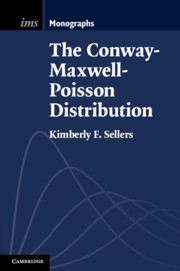Book contents
- Frontmatter
- Dedication
- Contents
- Figures
- Tables
- Preface
- Acknowledgments
- 1 Introduction: Count Data Containing Dispersion
- 2 The Conway–Maxwell–Poisson (COM–Poisson) Distribution
- 3 Distributional Extensions and Generalities
- 4 Multivariate Forms of the COM–Poisson Distribution
- 5 COM–Poisson Regression
- 6 COM–Poisson Control Charts
- 7 COM–Poisson Models for Serially Dependent Count Data
- 8 COM–Poisson Cure Rate Models
- References
- Index
7 - COM–Poisson Models for Serially Dependent Count Data
Published online by Cambridge University Press: 02 March 2023
- Frontmatter
- Dedication
- Contents
- Figures
- Tables
- Preface
- Acknowledgments
- 1 Introduction: Count Data Containing Dispersion
- 2 The Conway–Maxwell–Poisson (COM–Poisson) Distribution
- 3 Distributional Extensions and Generalities
- 4 Multivariate Forms of the COM–Poisson Distribution
- 5 COM–Poisson Regression
- 6 COM–Poisson Control Charts
- 7 COM–Poisson Models for Serially Dependent Count Data
- 8 COM–Poisson Cure Rate Models
- References
- Index
Summary
This chapter considers various models that focus largely on serially dependent variables and the respective methodologies developed with a COM–Poisson underpinning. This chapter first introduces the reader to the various stochastic processes that have been established, including a homogeneous COM–Poisson process, a copula-based COM–Poisson Markov model, and a COM–Poisson hidden Markov model. Meanwhile, there are two approaches for conducting time series analysis on time-dependent count data. One approach assumes that the time dependence occurs with respect to the intensity vector. Under this framework, the usual time series models that assume a continuous variable can be applied. Alternatively, the time series model can be applied directly to the outcomes themselves. Maintaining the discrete nature of the observations, however, requires a different approach referred to as a thinning-based method. Different thinning-based operators can be considered for such models. The chapter then broadens the discussion of dependence to consider COM–Poisson-based spatio-temporal models, thus allowing both for serial and spatial dependence among variables.
Keywords
Information
- Type
- Chapter
- Information
- The Conway–Maxwell–Poisson Distribution , pp. 251 - 283Publisher: Cambridge University PressPrint publication year: 2023
